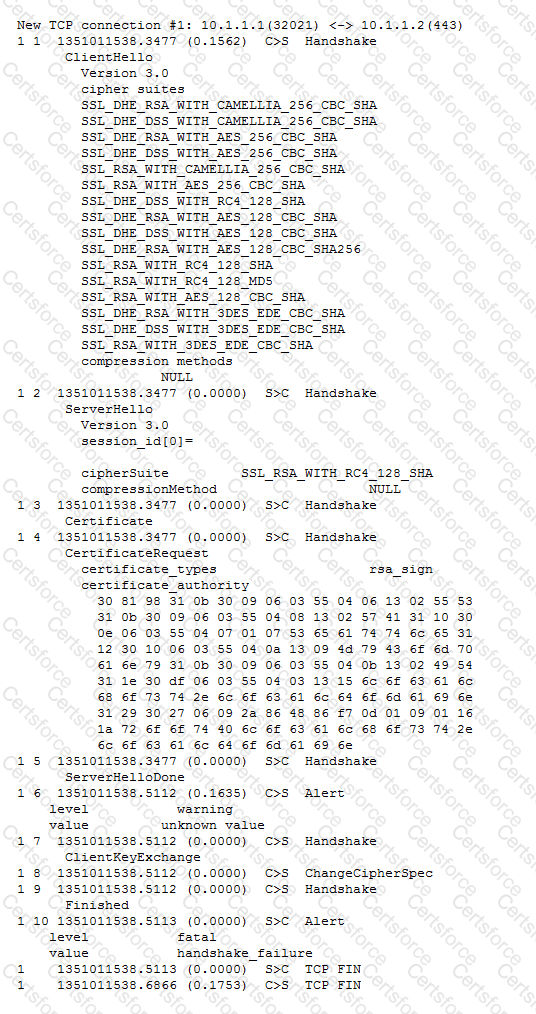An LTM device is load balancing telnet and ssh applications in a client/server environment experiencing significant packet delay.
Which setting in the TCP profile should reduce the amount of packet delay?
An LTM Specialist has configured a virtual server for www.example.com, load balancing connections to a pool of application servers that provide a shopping cart application. Cookie persistence is enabled on the virtual server. Users are able to connect to the application, but the user's shopping cart fails to update. A traffic capture shows the following:
Request:
GET /cart/updatecart.php HTTP/1.1
Host: www.example.com
Connection: keep-alive
Cache-Control: max-age=0
User-Agent: Mozilla/5.0 (Macintosh; Intel Mac OS X 10_7_5) AppleWebKit/537.4 (KHTML, like Gecko) Chrome/22.0.1229.94 Safari/537.4
Accept: text/html,application/xhtml+xml,application/xml;q=0.9,*/*;q=0.8
Accept-EncodinG. gzip,deflate,sdch
Accept-LanguagE. en-US,en;q=0.8
Accept-Charset: ISO-8859-1,utf-8;q=0.7,*;q=0.3
CookiE. BIGipServerwebstore_pool=353636524.20480.0000
Response:
HTTP/1.1 200 OK
DatE. Wed, 24 Oct 2012 18:00:13 GMT
Server: Apache/2.2.22 (Ubuntu)
X-Powered-By: PHP/5.3.10-1ubuntu3.1
Set-CookiE. cartID=647A5EA6657828C69DB8188981CB5; path=/; domain=wb01.example.com
Keep-AlivE. timeout=5, max=100
Connection: Keep-Alive
Content-TypE. text/html
No changes can be made to the application.
What should the LTM Specialist do to resolve the problem?
-- Exhibit –

-- Exhibit --
Refer to the exhibit.
An LTM Specialist is investigating reports that users are unable to perform some commands through an FTP virtual server. The users are receiving the FTP error "500 Illegal PORT command." The virtual server is configured to SNAT using automap. The LTM Specialist performs a capture on the server side of the LTM device.
Why is the server returning this error?
Given the log entry:
011f0005:3: HTTP header (32800) exceeded maximum allowed size of 32768 (Client sidE. vip=/Common/VS_web profile=http pool=/Common/POOL_web client_ip=10.0.0.1)
Which HTTP profile setting can be modified temporarily to resolve the issue?
-- Exhibit –

-- Exhibit --
Refer to the exhibit.
A layer 2 nPath routing configuration has been deployed. A packet capture contains a client connection packet with the following properties:
Source IP:
Destination IP:
At which two locations could the packet capture have been taken? (Choose two.)
The LTM Specialist is in the process of creating a USB boot drive for the purpose of restoring the BIG-IP software to an LTM device. A separate LTM device has been selected for the purpose of creating the USB boot drive. The BIG-IP software ISO has already been uploaded and mounted on the separate LTM device.
Which command should the LTM Specialist use to trigger the LTM device to install the BIG-IP software to the USB boot drive?
-- Exhibit –

-- Exhibit --
Refer to the exhibit.
A user is unable to access a secure application via a virtual server.
What is the cause of the issue?
A stand-alone LTM device is to be paired with a second LTM device to create an active/standby pair. The current stand-alone LTM device is in production and has several VLANs with floating IP addresses configured. The appropriate device service clustering (DSC) configurations are in place on both LTM devices.
Which two non-specific DSC settings should the LTM Specialist configure on the second LTM device to ensure no errors are reported when attempting to synchronize for the first time? (Choose two.)
-- Exhibit –

-- Exhibit --
Refer to the exhibit.
An LTM Specialist is troubleshooting an issue with SSL and is receiving the error shown when connecting to the virtual server. When connecting directly to the pool member, clients do NOT receive this message, and the application functions correctly. The LTM Specialist exports the appropriate certificate and key from the pool member and imports them into the LTM device. The LTM Specialist then creates the Client SSL profile and associates it with the virtual server.
What is the issue?
A client is attempting to log in to a web application that requires authentication. The following HTTP headers are sent by the client:
GET /owa/ HTTP/1.1
Authorization: Basic dXNlcm5hbWU6cGFzc3dvcmQ=
User-Agent: curl/7.26.0
Host: 10.0.0.14
Accept: */*
Accept-EncodinG. gzip,deflate
The web server is responding with the following HTTP headers:
HTTP/1.1 401 Unauthorized
Content-TypE. text/html
Server: Microsoft-IIS/7.5
WWW-AuthenticatE. NTLM
DatE. Wed, 16 Aug 1977 19:12:31 GMT
Content-LengtH. 1293
The client has checked the login credentials and believes the correct details are being entered.
What is the reason the destination web server is sending an HTTP 401 response?